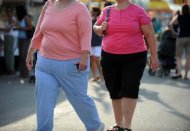2012年7月20日星期五
靜脈曲張一成人無蚯蚓 肥胖脂肪掩蓋 傷口潰瘍方知
【明報專訊】長期站立可導致下肢靜脈曲張,患者初期普遍發現腳部血管如蚯蚓般腫脹突出,但有肥胖病人因皮下脂肪厚,肉眼看不見血管有異樣而忽略病情,直至一次撞傷小腿,傷口久久無法癒合,始發現患上嚴重的靜脈曲張。有醫生指出,約一成患者有類似情况,如經常感到下肢沉重,可能已是靜脈曲張的病徵。
肥胖教師以為糖尿腳
30多歲、現職教師的胡先生,身形肥胖,體重達200磅,因工作關係要長時間站立。約年半前他發現右腳小腿皮膚變深色,還間中痕癢,誤以為是皮膚敏感。
半年後,胡不慎撞傷小腿近腳踝位置,但傷口遲遲不能癒合又經常流血,他一度以為是糖尿腳,最終經醫生以超聲波診斷,證實他的靜脈曲張已惡化,要透過射頻手術將出事血管封閉,加上穿上壓力襪和增加運動,傷口才慢慢改善,靜脈曲張一年來也沒有復發。
膚色變深乾燥痕癢為警號
外科專科醫生熊健解釋,缺乏運動、長期站立的人,下肢靜脈瓣膜容易變得未能正常閉合,令血液倒流,血管擴張,形成靜脈曲張。大部分初期病人腳部血管突出如蚯蚓,腿部腫脹,血液循環漸受破壞,令皮膚失去養分,出現變深色、乾燥和痕癢。嚴重病患若有傷口,便會難以癒合造成潰瘍。
不過並非所有病人均能及早察覺患病,熊說約有一成病人在腳部皮膚變黑,甚至潰爛才發現患上靜脈曲張,這些病人多是肥胖,或皮膚纖維化變得又乾又硬,單憑肉眼看不到是血管出問題。他提醒市民若出現下肢沉重,皮膚變黑和痕癢,便有可能患上靜脈曲張,建議盡早求醫確診。
2012年7月9日星期一
六成港人有脂肪肝 缺乏運動 能量有入無出
-A
+A
明報 – 2012年7月4日星期三下午8:06
脂肪肝和早期的肝纖維化可以透過飲食和運動改善病情,患有三高(高血脂、高血糖、高血壓)及中央肥胖者應定期檢查肝臟健康情况。纖維化會令肝臟失去彈性,肝纖維掃描的探頭
腸胃及肝臟科專科醫生王振宇(鄭寶華攝)
【明報專訊】可樂中的焦糖色素,最近被指含致癌物質。原來早有研究指出,汽水中的焦糖色素會增加胰島素抗阻及炎症,所以即使飲用健怡汽水,亦會增加患上代謝綜合症和脂肪肝的風險。
香港肝壽基金正進行一項調查,初步結果顯示,香港超過六成人有脂肪肝;脂肪肝是富貴病,肝臟囤積過量脂肪,會令肝臟慢性發炎,導致纖維化,併發肝硬化和肝癌。
香港中文大學曾在2008至2010年間進行全民肝臟健康普查,研究發現有28.6%受訪者是脂肪肝患者。香港肝壽基金行政主任林淑貞指出,今年初香港肝壽基金與紅十字會合作,為超過2000市民進行肝臟超聲波、纖維化掃描及抽血檢查,初步發現有超過六成人有脂肪肝,情况令人憂慮。
「肝臟其實好似一個錢罌,將身體多餘的能量儲存起來,待出現飢餓或患病期間,身體出現營養不足時應用;但香港人生活太豐裕,又缺乏運動,結果儲備愈來愈多,有入無出。」腸胃及肝臟科專科醫生王振宇指出,正常肝臟脂肪量不應超過5%,一旦超標,就是脂肪肝。
併發肝硬化肝癌
「脂肪肝可分為因過量飲酒所致的『酒精性脂肪肝』,及與肥胖和代謝綜合症關係密切的『非酒精性脂肪肝』,而香港患者九成屬於後者。」王振宇解釋,肝臟積聚過量脂肪細胞,令正常的細胞受壓,影響肝臟功能;若情况持續,肝臟發大,壓壞正常細胞及引起炎症,導致纖維化,「研究指出,三成嚴重脂肪肝患者會在10至30年內死於肝癌或其他肝病」。
要確診脂肪肝,需要進行肝穿刺活組織檢查,將針直接刺進肝臟抽取組織化驗,屬創傷性檢查,可能有出血風險;所以,醫生一般只會透過驗血檢查肝酵素,及利用超聲波檢查、肝纖維掃描作診斷。
大肚腩阻照超聲波
「超聲波檢查是常用的方法,利用超聲波影像觀察肝臟的光暗和質感,可以判斷脂肪肝和纖維化的情况。」不過,對於中央肥胖的大肚腩人士,因脂肪層太厚,可能會影響超聲波檢查的準確度,而肝纖維掃描檢查則有專為大肚腩而設的加大碼探頭,「肝纖維掃描是利用探測器傳送聲波至肝臟,然後反彈,量度肝臟的柔軟度,從而計算出肝纖維化的程度;常用的中碼探頭,可量度至皮下6.5厘米,而加大碼探頭則可量度至皮下7.5厘米。」不過,王振宇指出,肝纖維掃描只能診斷肝纖維化,不能診斷脂肪肝。
文﹕鄭寶華
圖﹕陳淑安、鄭寶華
編輯 屈曉彤
美術 SIUKI
2012年7月8日星期日
2012年6月30日星期六
睽違13年 FDA通過最新款減肥藥
相關內容
 查看相片睽違13年 FDA通過最新款減肥藥
查看相片睽違13年 FDA通過最新款減肥藥
英研究:胖子威脅地球永續
相關內容
 查看相片英研究:胖子威脅地球永續
查看相片英研究:胖子威脅地球永續
2012年3月22日星期四
美法院判決:麥克雞塊不是雞,是怪物
美法院判決:麥克雞塊不是雞,是怪物
撰文者:麥可.波倫
來源:《雜食者的兩難》 2012-03-14
至少在這位消費者的心目中,雞塊和雞肉的關聯不過是種抽象的概念,甚至是沒有關聯。以撒拿一塊到我和朱蒂絲面前,要我們嘗嘗。它看起來和聞起來都不錯,外皮漂亮,潔白的內部讓人聯想到雞胸肉,它的外表和質地的確讓人聯想到炸雞。但是放入口中,我吃到的只有鹹味,那種所有速食都有的風味;好吧,可能還帶有一點雞湯味。
總而言之,雞塊比較像是個抽象物質,而不是真正的食物,裡面有關雞的成分還得再加強。
傳單上列出的原料,讓我想到許多有關雞塊和玉米的事。麥克雞塊的原料有38項,我算出其中有13種可以從玉米培育或提煉出來:玉米養大的雞、修飾玉米澱粉(好把磨碎的雞肉黏起來)、單酸甘油酯、二酸甘油酯、三酸甘油酯(這些乳化劑能避免油脂與水分離)、右旋糖、卵磷脂(也是乳化劑)、雞湯(好補回加工時流失的一些風味)、黃色玉米粉和更多的修改玉米澱粉(好讓原料調成糊狀)、玉米澱粉(填充物)、植物性起酥油、部分氫化玉米油、檸檬酸(防腐劑)。
此外,麥克雞塊還有其他的植物成分,例如麵粉(增加黏稠度),至於氫化油有時候可能是來自大豆、芥菜籽或棉籽而非玉米,這要看當時的市場價格和供應量而定。
根據傳單,麥克雞塊中還含有數種完全由人工合成的原料,這些看似能吃的物質並非來自玉米田或大豆田,而是煉油廠或化學工廠。這些化合物能夠讓有機原料歷經數月的冷凍和運送之後,不會走味或是變樣,現代的加工食品才有可能出現。排在前面的是發酵劑,包括了磷酸鈉鋁、磷酸單鈣、焦磷酸鈉以及乳酸鈣。這些化合物都是抗氧化劑,能夠讓雞塊中的各種動物油脂與植物油脂不會發出油耗味。接下來是聚二甲基矽氧烷之類的消泡劑,主要是添入烹飪油中,可避免澱粉與空氣分子結合,這樣油炸時就不會產生泡沫。但最大的問題在於,這種有毒物質竟被允許添加在食物中。
根據《食品添加物手冊》,聚二甲基矽氧烷疑似致癌物質,而且確定會造成突變、腫瘤與生殖器官問題,同時也是易燃物。
不過麥克雞塊中最驚人的成分,應該是第三丁基氫醌(TBHQ)。這是石油製成的抗氧化劑,會直接噴在雞塊上,或是噴在雞塊盒子內側,以「保持雞塊鮮度」。
根據《消費者食品添加物字典》的記載,第三丁基氫醌是丁烷(打火機的燃油也屬於丁烷)的衍生物,美國食品及衛生管理局允許加工業者少量使用在食物上,其含量要低於0.002%。吃下一公克的第三丁基氫醌,會讓人「噁心、嘔吐、耳鳴、產生幻覺、感到窒息與虛脫」,如果吃下五公克就會死亡。
這麼多奇怪的分子組織成如此複雜的食物,你應該可以知道雞塊了不起之處不僅在於能讓孩子接受,而且把他們餵飽還不用花很多錢。泰森公司於一九八三年應麥當勞的要求,發明了雞塊。有了雞塊,雞肉便超越牛肉,成為美國最受歡迎的肉類。
2012年3月17日星期六
快走可降低肥胖基因影響
相關內容
 查看相片
查看相片研究:快走可降低肥胖基因影響
(法新社華盛頓15日電) 最新研究今天指出,久坐 的生活型態會強化肥胖基因特性,但只要每天短時間快 步行走,影響便可以降低一半。 研究報告作者祁起賓(Qibin Qi, 音譯)說:「這 是頭一次有人直接探討看電視的久坐行為,究竟如何影 響肥胖基因易發性患者的身體質量指數(BMI)。」 研究報告本周在加州聖地牙哥美國心臟協會( American Heart Association)所舉辦的會議中公開發 表。 祁起賓指出,只要每天步行一小時,就能「降低基 因對於肥胖症的不良影響,以身體質量指數計算,風險 約可減低一半。」 研究人員先在兩年期間,以7740名女性和4564名男 性作為研究對象,蒐集體能活動和看電視時間等相關資 料,然後開始計算他們的BMI。 美國人平均每天看電視的時間是4到6小時。(譯者 :中央社楊樹根)1
多吃白米增糖尿風險 哈佛研究 倡亞洲人多吃糙米
【明報專訊】哈佛大學一項大型研究顯示,吃白米太多會增加患糖尿病風險,尤以喜愛吃飯的亞洲人受影響最大。研究中的中國及日本對象群組,吃最多白米的一群患「二型糖尿病」的機會率,較吃白米最少的一群高出55%。研究建議亞洲人多吃較多纖維質的健康糙米,以保障健康。
營養師﹕白粥風險或更高
香港註冊營養師張翠芬稱,科學界已得悉白米的「升糖指數」較糙米高,對糖尿病人風險較大,因巿民吃白米較容易至血糖急劇上升而損害血管。她提醒,白粥的風險可較白米大,因白米煮爛變成粥後會易被人體吸收,故糖尿病人飲食要特別小心。
張翠芬指出,糖尿病人視乎體型,建議每餐不宜吃超過大半碗或一碗白米,並可逐步混入較健康的糙米,又或在餐單適量加入蔬菜、瘦肉碎等,以減少碳水化合物的吸收。
美國哈佛大學公共衛生學院就全球35萬人的飲食習慣,進行4至22年跟蹤研究,去年研究已發現每周至少吃5餐白米飯的美國成人,患二型糖尿病的機會率較每周僅吃一頓白米飯的高17%;若把三分之一白米換成健康糙米,可減二型糖尿風險16%。
料因加工後只餘澱粉質
哈佛研究人員在英國醫學期刊發表的最新數據,則指愈喜歡吃飯的國家受訪者,白米引起的糖尿病風險亦較高。在中國及日本研究對象中,吃最多白米的一群(每日吃3至4份白米),患二型糖尿病的機會率較吃最少白米的一群高55%。至於吃白米較少的美國及澳洲研究對象,吃白米最多及最少一群的患二型糖尿機會率只相差17%。
研究人員估計,白米的糖尿風險源於它經加工後只餘澱粉質,相對上較少加工的糙米含較豐富的纖維質、鎂及維他命,令升糖指數較低亦較健康。不過,研究人員強調並不是說單是多吃白米便易患糖尿病,因尚有其他食物或生活習慣亦會對健康有影響,未來將就此作更深入研究。
據美國疾控預防中心估計,全球約有3.5億名成人患二型糖尿,原因估計包括不良飲食習慣、肥胖、缺乏運動等。
2012年3月9日星期五
Secret Ingredients

Secret Ingredients
Most of the processed foods we eat are studded with mysterious additives. They extend shelf life. They create exciting flavors, colors and textures. But they don’t do great things for our health. Find out which ones to avoid, and why.
By Kristin Ohlson / November 2011
A few years ago, chef and food writer Steven Ettlinger bought his children a package of ice-cream bars. Out of habit, he read the list of ingredients — aloud. While doing so, his little girl interrupted him by asking, “What’s polysorbate 60, Daddy?” Because Ettlinger had no idea, he decided to find out.
During the course of his research, Ettlinger learned that what his daughter was eating — polysorbate 60 — is an emulsifier commonly used in a variety of processed foods, including baked goods and frozen desserts. Greasy and light brown in color, it’s made from a combination of hydrogenated corn syrup from the Midwest, Malaysian palm oil that’s been converted into stearic acid (also an ingredient in shampoos), and ethylene oxide, made from a component of natural gas — a substance used as an explosive during the Vietnam War.
Compelled, Ettlinger went on to discover that there are thousands of colorings, flavorings, artificial sweeteners, preservatives, leavening agents, antioxidants or other food additives in the processed foods we buy. And he wound up writing about a lot of them in a book called Twinkie, Deconstructed: My Journey to Discover How the Ingredients Found in Processed Foods Are Grown, Mined (Yes, Mined), and Manipulated into What America Eats (Plume, 2008).
“We know where the grapes for Bordeaux wine are grown, and I’ve seen countless pictures of winemakers standing in the middle of their fields,” Ettlinger says. “I wondered if you could do the same thing with something like polysorbate 60.”
In his book, Ettlinger focuses on the 39 ingredients found in a package of Twinkies, one of America’s most iconic foods. But his goal, he says, was not to pass judgment on the $23 billion industry that manufactures food additives. It was to feed his own curiosity.
He was fascinated by how these additives are made and what role they play in the manufacturing and marketing of processed foods. Why, he wanted to know, would something as simple as a Twinkie require 39 ingredients? Certainly you could make a Twinkie-like cake at home with just a handful of pantry staples.
Part of the reason for all the additives, he found out, has to do with quantity over quality. “The batter has to stand up to the demands of mass production,” Ettlinger says. “One of the reasons they add cellulose gum to Twinkie batter is to keep the bubbles from being crushed at the bottom of a 4,000 gallon mixing vessel. When you make a cake at home, the little bubbles are under a few inches of batter. When they’re under 4 feet of batter, it’s a problem.”
Built to Last
For as long as commercial food machinery has been humming, additives have been deemed necessary to keep processed food palatable, attractive and safe from spoilage. An invention born of necessity, they were designed to disguise the multitude of sins that make our modern food industry tick: the long stretch of time between harvest and consumption; the blandness of commodity ingredients; the rigors of harsh, high-volume factory production methods. All these things call for high-tech ingredients and interventions.
In 1911 Crisco was introduced as a low-cost, long-shelf-life alternative to butter and lard. It was the first commercial food containing trans fats. Other factory-made substances soon followed.
In the midcentury, the volume of food additives began escalating dramatically. In the United States, for example, the quantity of food dyes consumed per capita rose from 10 milligrams in 1955 to 60 milligrams in 2009.
It’s not always clear, particularly in the short term, what effect such additives have. The use of some natural additives — including tocopherols (vitamin E) and ascorbic acid (vitamin C) as antioxidant preservatives, and the spice turmeric as a coloring — is widely considered totally benign.
And for people who stick with fresh, unprocessed food, avoiding the less wholesome class of food additives is fairly easy. Unfortunately, most Americans don’t fall into that category.
One estimate suggests that processed food comprises 75 percent of our national diet and, as a result, the average American eats 8 to 10 pounds of additives each year.
Consume At Your Own Risk
So who gauges the safety of all these additives? That job falls to the Food and Drug Administration (FDA), which reviews the research regarding each new chemical before it’s introduced to the marketplace. The trouble is that the FDA is woefully underfunded and understaffed — and some experts believe it is not entirely objective in its evaluations.
That’s a lesson Ruth Winter, MS, learned the hard way. In 1979, after her daughter developed hives and their doctor suggested she might be allergic to the penicillin in commercial milk, Winter began doing a lot of research, which eventually became a book, A Consumer’s Dictionary of Food Additives (Three Rivers Press, 2009).
“Who knew there was penicillin in the milk?” Winter asks. “I thought there was an FDA employee looking over everyone’s shoulder, making sure our food is safe. But that’s simply not the case.”
Another problem: Much of the research the FDA reviews comes from the companies that produce the chemicals in question; clearly those companies have a vested interest in designing studies that look favorable. And, historically, there’s been a bit of a revolving door between the executive suites of big food and chemical companies and the FDA’s leadership circle.
For these reasons and more, critics say, the FDA is reluctant to challenge these companies, especially when newer independent research raises questions about substances the agency gave the all-clear on long ago.
“It seems to me that the FDA bends over backwards not to find problems with food additives,” says Michael Jacobson, PhD, executive director of the Center for Science in the Public Interest (CSPI). “Once they approve a chemical, then they have a bureaucratic investment in defending its safety and their previous decision. In some cases, they even prevent other government agencies from conducting research.”
Jacobson claims, for example, that the National Toxicology Program — which does lab tests for government agencies — was considering testing one or more questionable artificial sweeteners for toxicity, but the FDA discouraged them from proceeding.
CSPI routinely petitions the FDA about food additives, especially when new independent research comes to the fore. Earlier this year, for example, an FDA panel responded to CSPI’s petition regarding artificial colorings, which two large studies funded by the British government showed to cause or exacerbate hyperactivity in children. CSPI wanted a ban on the colorings, or at least a warning label.
Some scientists had earlier agreed that children with already-existing ADHD (attention deficit hyperactivity disorder) may have worsening symptoms from the colorings. While a hotly divided FDA panel ultimately declined to change anything, CSPI’s action made millions of people think about the colors in their children’s breakfast cereals and fruit snacks.
“These foods are unhealthy for so many reasons,” says David Schab, MD, MPH, a professor of psychiatry at Columbia University. Schab testified before the FDA panel on food colorings, since he had conducted a meta-analysis of all the literature on these additives and found a significant increase in hyperactivity for children with ADHD. “We’re in the middle of this huge obesity epidemic that threatens both our health and the economy. It would be great if government agencies did something to make unhealthy foods less appealing,” he says.
“Of all the additives, artificial sweeteners are my top concern,” says David Katz, MD, MPH, FACPM, FACP, director of the Yale University Prevention Research Center and editor-in-chief of Childhood Obesity. “There is one harm that clearly is supported by science: They propagate a sweet tooth. They are intensely sweet, and the literature shows that they stimulate the same reward center as sugar. I think that tends to result in a preference for ever-sweeter foods, with attendant harms to health and weight.”
What’s the best way to avoid harmful food additives? Abstain from processed food completely. “If it’s not something the body evolved to eat, I err on the side of caution,” says functional nutritionist Julie Starkel, MS, MBA, RD.
For when you are in a pinch, though, and not sure of an ingredient, we have compiled the following list of the most critical additives to avoid, based on warnings from the CSPI and other experts.
Some have raised red flags during testing. Others have not been tested well enough to prove safety — especially given today’s more sensitive and precise methods of testing.
“People used to consider a substance safe if it didn’t kill a lab animal,” says nutritional biochemist Jeffrey Bland, PhD. “Now, we find that certain substances that used to be considered safe have an impact on cellular or metabolic function. Most of today’s food additives haven’t been adequately defined as safe, given these new methods.”
http://experiencelife.com/article/secret-ingredients/








